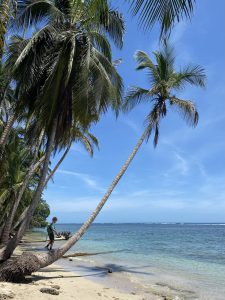 We had been in Costa Rica in 2019. It was our last ‘far away’(with flights) trip before we would have to pay the full price for the kids. We really loved all the nature and exotic animals so we had high expectations for this trip also. But it turned out that the ‘vanlife’ experience is a bit different than our previous visit…
We had been in Costa Rica in 2019. It was our last ‘far away’(with flights) trip before we would have to pay the full price for the kids. We really loved all the nature and exotic animals so we had high expectations for this trip also. But it turned out that the ‘vanlife’ experience is a bit different than our previous visit…
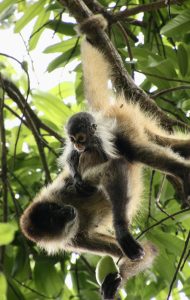 We are just a couple of kms into Costa Rica but the world looks completely different. All of a sudden there is a lot of green and animals are everywhere. We stay at a finca (farm) owned by a Swiss family and within an hour we spot monkeys, a crocodile and 3 sloths. We stay here a couple of days and every morning we go on one of the Swiss style hikes (Wanderwege) on their huge property. Each time we are guided by the two German Shepherds of the family. Which is quite convenient. The only problem was that they would chase away all the wildlife we come across.
We are just a couple of kms into Costa Rica but the world looks completely different. All of a sudden there is a lot of green and animals are everywhere. We stay at a finca (farm) owned by a Swiss family and within an hour we spot monkeys, a crocodile and 3 sloths. We stay here a couple of days and every morning we go on one of the Swiss style hikes (Wanderwege) on their huge property. Each time we are guided by the two German Shepherds of the family. Which is quite convenient. The only problem was that they would chase away all the wildlife we come across.
During our stay we also discover another way of ‘overlanding’ when a ‘caravan’ of 15 trucks and vans comesdriving in the finca. These people are traveling with their own vehicles from Argentina to the USA, but as part of an organized and guided trip. In 200 days they drive from Buenos Aires to the USA (via Ushuaia). Even though we see some advantages in this way of travelling we are happy that we can drive our own route at our own pace.
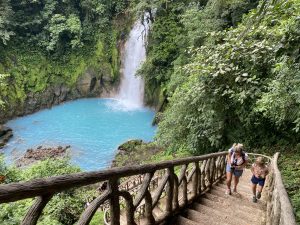 After a quick detour via the coast to pick up our drone (that we had to ship because they are illegal in Nicaragua), we head up to Tenorio National Park. The park is most famous for a clear blue waterfall on the Rio Celeste, but we really like the rest of the hikes here too. Highlight of the trip however is spotting an eyelash pit viper next to this trail. This beautiful little snake could fit into the palm of Lucie’s hand but is seriously venomous.
After a quick detour via the coast to pick up our drone (that we had to ship because they are illegal in Nicaragua), we head up to Tenorio National Park. The park is most famous for a clear blue waterfall on the Rio Celeste, but we really like the rest of the hikes here too. Highlight of the trip however is spotting an eyelash pit viper next to this trail. This beautiful little snake could fit into the palm of Lucie’s hand but is seriously venomous.
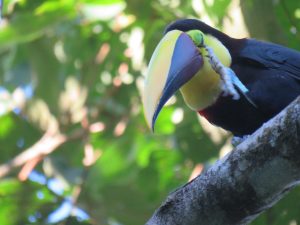 We spend the night close to the park and the altitude makes for a first cool night in weeks. So we quickly decide to stay around a bit longer before going back to the coast to meet our friends. We find an amazing campground that has just opened. It is on a huge, gorgeous piece of land with its own jungle trails and Rio Celeste river access. And it is full of birds! There is a beautiful bird watching platform but the toucans, aricaris and other colourful birds are also flying around our van all day. A friend of the owner shows us some really cool frogs in the evening and with his tips, we set out every evening to find more of them.
We spend the night close to the park and the altitude makes for a first cool night in weeks. So we quickly decide to stay around a bit longer before going back to the coast to meet our friends. We find an amazing campground that has just opened. It is on a huge, gorgeous piece of land with its own jungle trails and Rio Celeste river access. And it is full of birds! There is a beautiful bird watching platform but the toucans, aricaris and other colourful birds are also flying around our van all day. A friend of the owner shows us some really cool frogs in the evening and with his tips, we set out every evening to find more of them.
 There is however another really cool animal around that we would really like to see. The valley we camp in, has a small population of tapirs and the owner tells us that sometimes at daybreak one of them comes wandering through the grounds of the campground. These animals are very rare in Central America so every morning our main wildlife spotters (Caro & Leon) get up at 5am to look for the Tapir (also known as ‘Dante’ here). But without luck. On one of the last days we are there, they have a bit of a hard time getting up, so I decide to go out for a look myself. And I’m only just out of the van, when I see something grazing maybe 40m from the van. I first thought it was a small horse. But after wiping my glasses clean, I realize it is a big male tapir. I quickly run back to the van to wake up the others. Not even a minute later everybody is out (in pyjamas) and for more than half an hour we are able to watch this amazing animal look for food.
There is however another really cool animal around that we would really like to see. The valley we camp in, has a small population of tapirs and the owner tells us that sometimes at daybreak one of them comes wandering through the grounds of the campground. These animals are very rare in Central America so every morning our main wildlife spotters (Caro & Leon) get up at 5am to look for the Tapir (also known as ‘Dante’ here). But without luck. On one of the last days we are there, they have a bit of a hard time getting up, so I decide to go out for a look myself. And I’m only just out of the van, when I see something grazing maybe 40m from the van. I first thought it was a small horse. But after wiping my glasses clean, I realize it is a big male tapir. I quickly run back to the van to wake up the others. Not even a minute later everybody is out (in pyjamas) and for more than half an hour we are able to watch this amazing animal look for food.
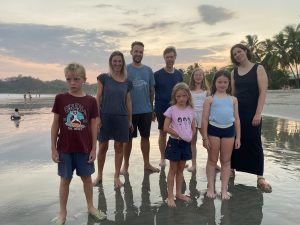 And then it is time to go back to the coast to meet Barbara, Bart & Co, our friends (and neighbours) who came over for a visit. We spent the last days of their holidays together at Samara beach. Time for relaxing, swimming, cocktails and also some surf classes.
And then it is time to go back to the coast to meet Barbara, Bart & Co, our friends (and neighbours) who came over for a visit. We spent the last days of their holidays together at Samara beach. Time for relaxing, swimming, cocktails and also some surf classes.
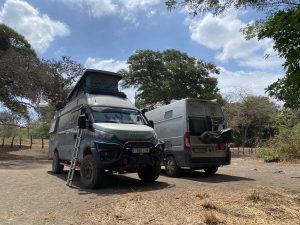 After a goodbye with some tears, we start driving away from the coast but are stopped by a guy on a quad bike. Jean Pierre from Knokke (Belgium) has seen our Belgian plates and is really curious what we do here. He has permanently moved to Costa Rica after his retirement and loves it here. He has started a couple of businesses (West Flemish blood is thicker than water) and is enjoying life the ‘Tico’/Pura Vida way. A very cool meeting but we need to get back on the road. We plan to drive (a long way) to the southern beaches and since the bridge to the main land is closed for repair, we decide to take a ferry. When we arrive at the ferry, there are huge lines. In addition to the closed bridge, one of the two available ferries has destroyed the dock. So now everyone needs to take the only available ferry. Chaos! After waiting for almost two hours, we decide to drive all the way back north and then continue south the next day. That evening we arrive in Liberia completely exhausted and plan to crash at a gas station for the night. While we are having a quick dinner, we meet another ‘vanlife’ family and they have a great tip for a sleeping spot. So we drive over there in the dark and discover a cool place by the river the next morning. We hadn’t met any long time traveling families for a long time, so it was great to meet the family from Catalonia and talk about the life on the road with kids.
After a goodbye with some tears, we start driving away from the coast but are stopped by a guy on a quad bike. Jean Pierre from Knokke (Belgium) has seen our Belgian plates and is really curious what we do here. He has permanently moved to Costa Rica after his retirement and loves it here. He has started a couple of businesses (West Flemish blood is thicker than water) and is enjoying life the ‘Tico’/Pura Vida way. A very cool meeting but we need to get back on the road. We plan to drive (a long way) to the southern beaches and since the bridge to the main land is closed for repair, we decide to take a ferry. When we arrive at the ferry, there are huge lines. In addition to the closed bridge, one of the two available ferries has destroyed the dock. So now everyone needs to take the only available ferry. Chaos! After waiting for almost two hours, we decide to drive all the way back north and then continue south the next day. That evening we arrive in Liberia completely exhausted and plan to crash at a gas station for the night. While we are having a quick dinner, we meet another ‘vanlife’ family and they have a great tip for a sleeping spot. So we drive over there in the dark and discover a cool place by the river the next morning. We hadn’t met any long time traveling families for a long time, so it was great to meet the family from Catalonia and talk about the life on the road with kids.
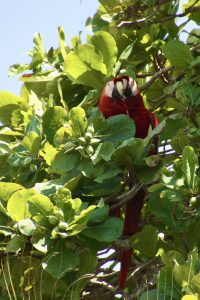 The next days, we drive down the Southern Pacific Coast, we see the first rains of the wet season and also see everything getting greener. We stop at the famous crocodile bridge and sleep at Playa Esterillos where we find a dozen of gorgeous ‘red macaw’ in the trees above our van. At our next spot we meet the Catalan family again. But we also meet with John and Monique again. A Dutch couple that we had met just before entering into Alaska 7 months earlier. It was great catching up and we also find out that they will ship their vehicle to South America on the same boat as us. So we will probably be seeing each other a bit more in the coming month. From the campground we are able to get in the National Park Marino Ballena that is right next to it. We go for a beach/jungle hike but can’t spot the whales this time (it’s late in the season). With our drone we are able to capture the amazing whale shaped beach for which the park is also very famous.
The next days, we drive down the Southern Pacific Coast, we see the first rains of the wet season and also see everything getting greener. We stop at the famous crocodile bridge and sleep at Playa Esterillos where we find a dozen of gorgeous ‘red macaw’ in the trees above our van. At our next spot we meet the Catalan family again. But we also meet with John and Monique again. A Dutch couple that we had met just before entering into Alaska 7 months earlier. It was great catching up and we also find out that they will ship their vehicle to South America on the same boat as us. So we will probably be seeing each other a bit more in the coming month. From the campground we are able to get in the National Park Marino Ballena that is right next to it. We go for a beach/jungle hike but can’t spot the whales this time (it’s late in the season). With our drone we are able to capture the amazing whale shaped beach for which the park is also very famous.
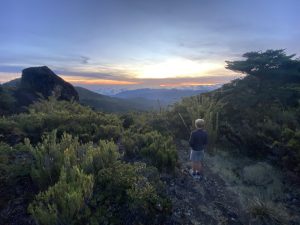 From the steaming hot Pacific coast, we escape into the highest cloud forests of Costa Rica. The temperatures drop quickly as we climb and during our sunset hike we are actually feeling cold. The next morning we hike up to a view point where we can see both the Pacific Ocean and Caribbean Sea. The cloud forests are not only known as good place to escape the coastal heat, but they are also the habitat of the mythical Maya bird: the Quetzal. This bird is not only very beautiful, but also notoriously hard to spot. In 2001, I spent two days looking for it in Guatemala and never caught a glimpse. When we visited Costa Rica in 2019, we were very lucky and spotted one on our first hike. For me, that was it: been there, seen it and even got a very good photo. Unfortunately, team birdwatching in our family is not having any of that. And so, as soon as we get in the quetzal habitat, this whole quest starts all over again.
From the steaming hot Pacific coast, we escape into the highest cloud forests of Costa Rica. The temperatures drop quickly as we climb and during our sunset hike we are actually feeling cold. The next morning we hike up to a view point where we can see both the Pacific Ocean and Caribbean Sea. The cloud forests are not only known as good place to escape the coastal heat, but they are also the habitat of the mythical Maya bird: the Quetzal. This bird is not only very beautiful, but also notoriously hard to spot. In 2001, I spent two days looking for it in Guatemala and never caught a glimpse. When we visited Costa Rica in 2019, we were very lucky and spotted one on our first hike. For me, that was it: been there, seen it and even got a very good photo. Unfortunately, team birdwatching in our family is not having any of that. And so, as soon as we get in the quetzal habitat, this whole quest starts all over again.
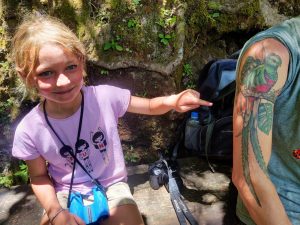 Our first attempt is not successful. We are not able to reach the observation area because the roads to get there are just way to steep for our van. Our second attempt brings us to the Cloudbridge reserve, where we planned a 8 km hike. We arrive when the park opens and make a very beautiful hike but do not see the quetzal. On our way out, a guide gives us a tip about a nest outside of the reserve. Our short hike now becomes a 16 km hike with +1500 m elevation. We are able to find the nest…but the quetzal does not show itself. After waiting for 2 hours we have to hike back down. We do spot some cool other things: transparent butterflies, a sleeping Motmot and… a quetzal tattoo.
Our first attempt is not successful. We are not able to reach the observation area because the roads to get there are just way to steep for our van. Our second attempt brings us to the Cloudbridge reserve, where we planned a 8 km hike. We arrive when the park opens and make a very beautiful hike but do not see the quetzal. On our way out, a guide gives us a tip about a nest outside of the reserve. Our short hike now becomes a 16 km hike with +1500 m elevation. We are able to find the nest…but the quetzal does not show itself. After waiting for 2 hours we have to hike back down. We do spot some cool other things: transparent butterflies, a sleeping Motmot and… a quetzal tattoo.
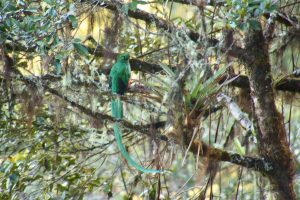 The next day we are pretty exhausted and we are both ready to give up the search. But during breakfast our son is already inquiring what our ‘next steps are to see the Quetzal. After quite a bit of research we find out about a campground where they are sometimes spotted. It is not on our planned route…but once this Quetzal madness gets in the van, there is no way around it! We camp high up in the cloud forests at a place where the quetzal is seen about two times a week by the owner. At night we hear a quetzal call ion the distance. The next morning, we get up at 5am. Early morning is the best time to see them as the shadows provide some cover to these birds. Once the sun hits their very colourful plumage, they become way too visible for predators. Around 6am out of nowhere the gorgeous bird flies in the valley just under us and lands in a tree not even 10m away. We quickly wake up the kids and start ‘clicking away’. Everyone gets a glimpse before it flies away just as gracefully as it came! We can now finally go back to a normal life.
The next day we are pretty exhausted and we are both ready to give up the search. But during breakfast our son is already inquiring what our ‘next steps are to see the Quetzal. After quite a bit of research we find out about a campground where they are sometimes spotted. It is not on our planned route…but once this Quetzal madness gets in the van, there is no way around it! We camp high up in the cloud forests at a place where the quetzal is seen about two times a week by the owner. At night we hear a quetzal call ion the distance. The next morning, we get up at 5am. Early morning is the best time to see them as the shadows provide some cover to these birds. Once the sun hits their very colourful plumage, they become way too visible for predators. Around 6am out of nowhere the gorgeous bird flies in the valley just under us and lands in a tree not even 10m away. We quickly wake up the kids and start ‘clicking away’. Everyone gets a glimpse before it flies away just as gracefully as it came! We can now finally go back to a normal life.
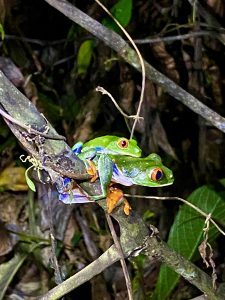 On our way to the Caribbean coast we follow another recommendation from other travelers: a jungle night tour at Centro Manu. At the request of our son, we ask our guide to look specifically for a number of frogs that are still missing in his ‘collection’: the ‘strawberry poison dart frog (aka ‘blue jeans frog) and the Red Eyed Tree frog. Leon spots the first frogs before the guide, so he gets a special torch as ‘assistant guide’. He is super proud! We find all the frogs on the list and much more. Our favourite is the last frog we come across: the ‘coronated tree frog’, who looks like a bodybuilder frog wearing a crown!
On our way to the Caribbean coast we follow another recommendation from other travelers: a jungle night tour at Centro Manu. At the request of our son, we ask our guide to look specifically for a number of frogs that are still missing in his ‘collection’: the ‘strawberry poison dart frog (aka ‘blue jeans frog) and the Red Eyed Tree frog. Leon spots the first frogs before the guide, so he gets a special torch as ‘assistant guide’. He is super proud! We find all the frogs on the list and much more. Our favourite is the last frog we come across: the ‘coronated tree frog’, who looks like a bodybuilder frog wearing a crown!
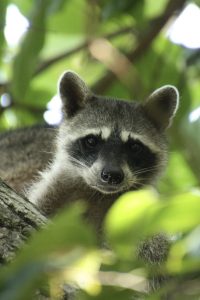 At the Caribbean coast, we visit our last National Park in Costa Rica: Cahuita NP. We go for a long walk switching regularly between beach and jungle and spot plenty of wildlife again: kingfishers, racoons, herons, coati, monkeys and thousands of crabs. This region has a very distinct vibe from the rest of the country. Maybe it is the omni present reggae music or the Rastas, but it often feels more like Jamaica than Costa Rica.
At the Caribbean coast, we visit our last National Park in Costa Rica: Cahuita NP. We go for a long walk switching regularly between beach and jungle and spot plenty of wildlife again: kingfishers, racoons, herons, coati, monkeys and thousands of crabs. This region has a very distinct vibe from the rest of the country. Maybe it is the omni present reggae music or the Rastas, but it often feels more like Jamaica than Costa Rica.
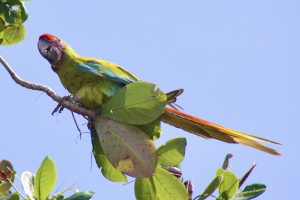 Our last nights in Costa Rica, we spend under the palm trees (but never under the coco nuts – we have seen the damage these can do to a vehicle!). Punta Uva is a gorgeous white sand beach and we take some time off to enjoy the beach and prepare the next steps. We also get very lucky to spot the rare Green Macaws in the trees around our campspot.
Our last nights in Costa Rica, we spend under the palm trees (but never under the coco nuts – we have seen the damage these can do to a vehicle!). Punta Uva is a gorgeous white sand beach and we take some time off to enjoy the beach and prepare the next steps. We also get very lucky to spot the rare Green Macaws in the trees around our campspot.
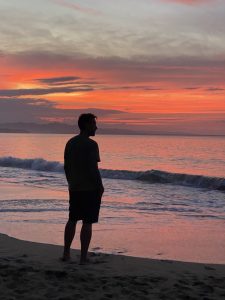 Unfortunately the weather is going to chase us away soon. Even though the temperatures are a bit lower than on the other side, the humidity at night (80-90 pct) is really making it nearly impossible to sleep. We have really really underestimated the impact of the heat and humidity of Central America! We feel that we are often not able to recover enough at night to keep going. We had planned to stay by some beaches for a longer period for relaxing and surfing but we always find ourselves, fleeing the heat.
Unfortunately the weather is going to chase us away soon. Even though the temperatures are a bit lower than on the other side, the humidity at night (80-90 pct) is really making it nearly impossible to sleep. We have really really underestimated the impact of the heat and humidity of Central America! We feel that we are often not able to recover enough at night to keep going. We had planned to stay by some beaches for a longer period for relaxing and surfing but we always find ourselves, fleeing the heat.
 We had an amazing 3 weeks in Costa Rica but our verdict is that due to the climate Costa Rica (as most of the Central American countries) is just not the best place to travel in a campervan (unless you have a huge AC installed).
We had an amazing 3 weeks in Costa Rica but our verdict is that due to the climate Costa Rica (as most of the Central American countries) is just not the best place to travel in a campervan (unless you have a huge AC installed).
It is also not that budget friendly to travel in a van. There are few free places to stay and the fact that they often charge per person, makes it expensive for families. Unfortunately there has also been an important rise in crime against camper vans lately. A lot of North Americans come here with their vans during winter and campervan rental is also really booming. As a result, campers have become a target. Especially along the southern Pacific coast there have been a lot of incidents recently…

wat een prachtig verslag. Wij genieten mee in het koudere België 🙂